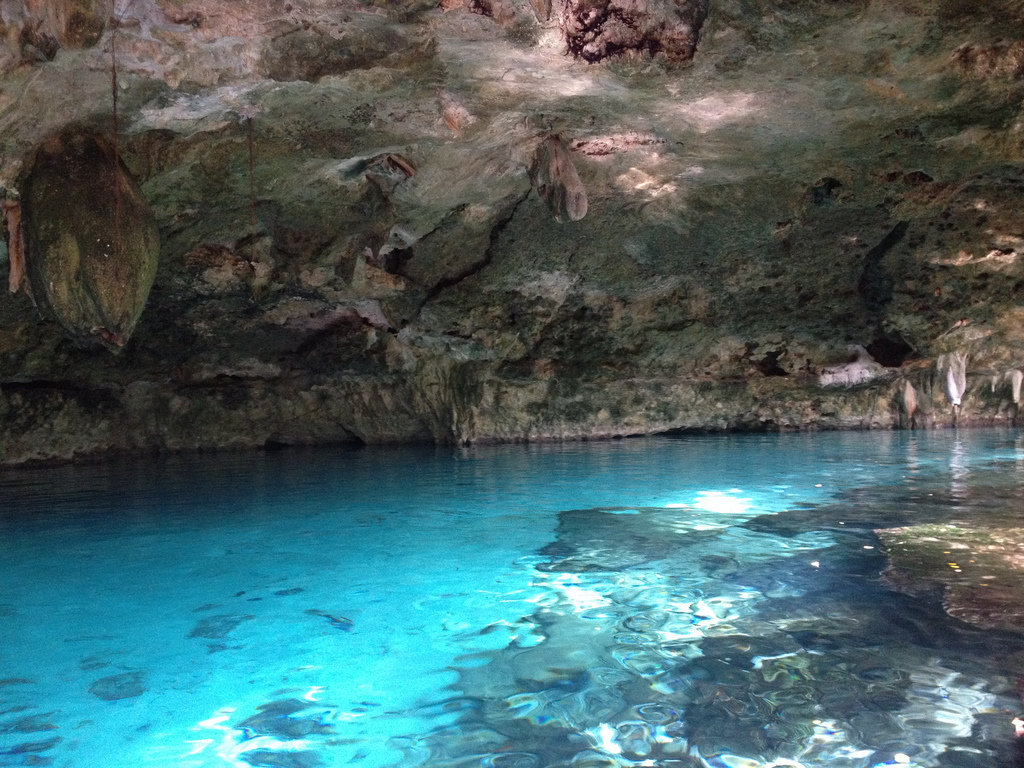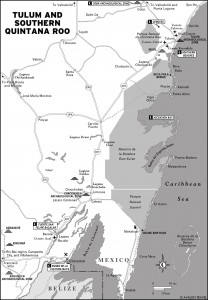
Popular swimming holes, cenotes are pools formed in limestone sinkholes. Photo © Christine Rondeau, licensed Creative Commons Attribution.
The road from Tulum Pueblo hits the coast near the upper end of the Zona Hotelera, which stretches from the archaeological zone down to the entrance of Sian Ka’an reserve, almost exactly 10 kilometers (6 miles). The area north of the Tulum/Zona Hotelera junction has two easy-to-reach beach areas that are ideal for people staying in town.Playa El Paraíso (Carr. Tulum-Punta Allen, 2 kilometers/1.2 miles north of junction, cell. tel. 984/113-7089, 8am-6pm daily, beach bar 8pm-midnight Thurs.-Sat.) is a popular beach club on a scenic beach of the same name. Once little more than a bar and some hammocks, the beach club has grown popular with tour groups and has morphed into a bustling expanse of lounge chairs, beach beds, and umbrellas (US$2-20/day), with waiters weaving between them. There’s a full restaurant and beach bar, and the nearby water sports center offers snorkeling, diving, kiteboarding, and more. It’s busy but still scenic and relaxing.
Directly north of Playa El Paraíso is Playa Mar Caribe, named after the rustic bungalows that have long fronted this portion of beach. Broad and unspoiled, this is a great place to come to lay out your towel on the soft white sand, which you share with a picturesque array of moored fishing boats. There are no services here, so be sure to bring snacks and plenty of water. (In a pinch, there’s a restaurant at the neighboring beach club.)

Tulum and Southern Quintana Roo
Tulum’s very best beaches—thick white sand, turquoise-blue water, gently bending palm trees—are toward the southern end of the Zona Hotelera. Not surprisingly, Tulum’s finest hotels are in the same area, and there are no official public access points. That said, hotels rarely raise an eyebrow at the occasional nonguest cutting through to reach the beach. You can also grab breakfast or lunch at one of the hotel restaurants and cut down to the beach afterward; in some cases, you can even use the lounge chairs.
Aimed at a mellow upscale crowd, Ana y José Beach Club (Carr. Tulum-Punta Allen, 2.4 kilometers/1.5 miles south of junction, no phone, 10am-6pm daily, free) is located about a kilometer north of the resort of the same name and is open to guests and nonguests alike. An airy sand-floored dining area serves mostly seafood, including ceviche, shrimp cocktail, and grilled fish, at decent prices and has a full bar. Chaise lounges and four-poster beach beds (US$5-15/day) are arranged a bit too close together, but they are comfy and relaxing nonetheless. Monday and Tuesday are the least crowded.
Once a modest roadside operation, Hidden Worlds (Hwy. 307 Km. 115, toll-free Mex. tel. 800/681-6755, toll-free U.S. tel. 888/339-8001, 9am-sunset daily, last tour leaves at 2pm) is now a full-blown package tourist attraction, and part of the international Rainforest Adventures company. It remains a great introduction to underground snorkeling or diving, with a gorgeous on-site cenote system, frequent departures, and a staff that’s accustomed to first-timers. A basic snorkeling tour (1 cenote, 1.5 hours) runs US$35, while one-tank dives are US$135; both including gear. The evergrowing list of nondiving attractions, including ziplines and rappelling, plus combo tours like “Ultimate Adventure + CoCoBongo,” make this a fun destination for the whole family but detract somewhat from the underwater options.
Dos Ojos (Hwy. 307 Km. 117, tel. 984/877- 8535, 8am-5pm daily) is located just north of Hidden Worlds but is far less commercialized. Dos Ojos, or Two Eyes, is a reference to twin caverns that are the largest openings—but far from the only ones—into the labyrinthine river system that runs beneath the ground here. You can snorkel on your own (US$10), but you’ll see a lot more on a guided snorkeling tour (US$40 pp, no reservations required); be sure to ask to visit the Bat Cave. After the tour, you’re free to keep snorkeling on your own; in fact, there are hammocks and benches, so you can bring food and drinks and make a day of it. Diving trips (US$130 for 2 tanks, maximum 4 divers per guide) should be arranged in advance. It’s two kilometers (1.2 miles) from the entrance to the cenotes, so a rental car is handy. Discounts are available if you have your own gear.
Other favorite cenotes include Zazil Ha Car Wash/Aktun Ha, Gran Cenote,, and Calavera Cenote (all west of Tulum on the road to Cobá); Cristal and Escondido (Hwy. 307 just south of Tulum); Casa Cenote (at Tankah Tres); Cenote Azul and Cristalina (Hwy. 307 across from Xpu-Há); and Chac Mol (Hwy. 307, 2 kilometers/1.2 miles north of Xpu-Há). All can be visited on a tour or by yourself, and most have snorkel gear for rent (US$6-8). Most are on private or ejido (collective) land and charge admission fees, usually US$3.50-6 for snorkelers and US$8.50 for divers. If you take a tour, ask if admission fees are included in the rate. Most cenotes are open 8am-5pm daily.
Excerpted from the Eleventh Edition of Moon Cancún & Cozumel.